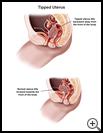
Tipped Uterus
________________________________________________________________________
KEY POINTS
- The uterus is the muscular organ at the top of the vagina. A tipped uterus tilts backward away from the front of the body.
- Usually you do not need treatment for a tipped uterus if it is not causing any problems. If the tipped uterus is causing pain, it may be treated with a vaginal pessary. A pessary is a device put into the vagina to help support the vaginal walls and pelvic organs.
- Ask your healthcare provider what symptoms or problems you should watch for and what to do if you have them.
________________________________________________________________________
What is a tipped uterus?
The uterus is the muscular organ at the top of the vagina. Babies grow in the uterus, and menstrual blood comes from the uterus. In most women the uterus tilts forward towards the front of the body. A tipped uterus tilts backward away from the front of the body.
Most often, a tipped uterus does not affect your ability to get pregnant. If you get pregnant, your uterus will probably tip forward naturally and you will have a normal delivery. Rarely, a very severely tipped uterus can get stuck in the pelvis as the baby grows. This may cause pain and trouble urinating. It might even cause loss of the pregnancy. However, this can be treated if it is found early in the pregnancy.
What is the cause?
You may have a tipped uterus because:
- Your uterus did not move forward as you grew up.
- The position of your uterus changed after you gave birth to a child.
- You have had fibroid tumors.
- You have scarring from abnormal growth of the uterine lining outside of the uterus (endometriosis), surgery, or an infection in your pelvis.
What are the symptoms?
Most women have no symptoms at all. Possible symptoms are trouble when trying to use tampons, problems urinating, and back pain, especially during your menstrual period.
How is it diagnosed?
Your healthcare provider will ask about your symptoms and medical history and examine you, including a pelvic exam. Tests may include:
- An ultrasound, which uses sound waves to show pictures of the uterus
- Laparoscopy, which uses a small lighted tube put into the belly through a small cut to look for problems such as fibroid tumors or scarring. Your healthcare provider may remove a small sample of tissue (biopsy) for tests.
How is it treated?
Usually you do not need treatment for a tipped uterus if it is not causing any problems.
If the tipped uterus is causing pain, it may be treated with a vaginal pessary. A pessary is a device put into the vagina to help support the vaginal walls and pelvic organs. It can help put the uterus in a more normal position.
If you have a laparoscopy to check for problems, your healthcare provider may be able to treat the cause of the tipped uterus during the procedure.

